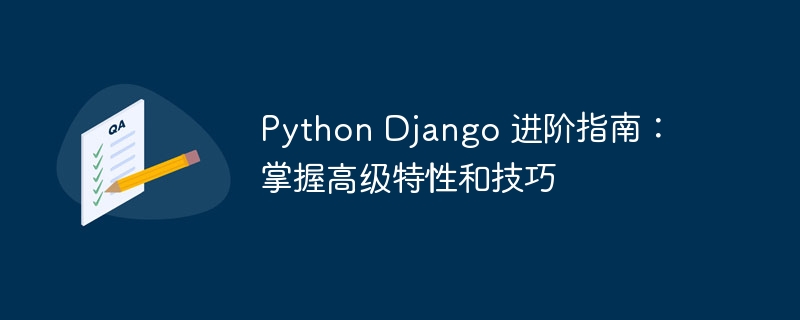Home >Backend Development >Python Tutorial >Advanced Guide to Python Django: Master Advanced Features and Techniques
Advanced Guide to Python Django: Master Advanced Features and Techniques
- WBOYWBOYWBOYWBOYWBOYWBOYWBOYWBOYWBOYWBOYWBOYWBOYWBforward
- 2024-03-27 21:46:42778browse

- Prefetching (Prefetching): Obtain related objects at one time, reducing the number of database queries.
- Select Related: Only select specific objects related to the current object instead of loading all related objects.
- Lazy Loading: Load objects only when needed to avoid unnecessary database queries.
-
Model Manager Optimization: Use
objects.filter().defer()andobjects.filter().only()to specify to exclude or Contained fields.
cache
-
Built-in caching: Use
<strong class="keylink">Django</strong>.core.cacheCache view output, database queries, and other content. - Third-party caching: Integrate third-party caching systems such as Memcached and Redis to provide higher performance and scalability.
- Invalidation strategy: Configure cache invalidation strategy, such as using signal handlers or active cleanup.
Security enhancement
-
Cross-site request forgery (CSRF) protection: Prevent malicious form submissions using
djan<strong class="keylink">Go</strong>.middleware.csrf.CsrfViewMiddleware. -
Cross-Origin Resource Sharing (CORS): Use
django.contrib.corsmiddlewareto configure the CORS header to allow cross-origin requests. -
Content Security Policy (CSP): Use the
Content-Security-Policyheader to limit the scripts, stylesheets, and other resources that are allowed to be loaded. -
Password hashing: Use
django.contrib.auth.hashersto provide a secure password hashing algorithm .
RESTful API
- Django REST Framework (DRF): A powerful library for creating RESTful api.
- Serializer: Defines how data is serialized and deserialized with formats such as JSON or XML.
- ViewSet: Handles Http actions such as GET, POST, PUT, and DELETE.
-
API version control: Use the
Vers<strong class="keylink">io</strong>ningclass or third-party library to implement API version control.
Deployment and Operation
- Docker: Use Docker Containerize your Django applications to simplify deployment and management.
- Heroku: Deploy and host Django applications using the Heroku cloud platform.
- AWS Elastic Beanstalk: Easily deploy and automatically scale Django applications with AWS’s hosting platform.
- Monitoring and logging: Use tools such as New Relic, Datadog, etc. Monitor and log application performance and errors.
Other advanced features
- Model inheritance: Create more complex models using models.Model
subclasses and reuse base class code. - Custom Manager: Create a custom model manager to provide additional filtering and querying capabilities.
- Custom forms and validation: Use django.f
ORM<strong class="keylink">s</strong> to create a custom form and add custom validation rules. - Generic Views: Use GenericViews
Provides generic views to simplify the creation of views for common operations. - Management Commands: Create custom management commands to perform specific tasks, such as data import or export.
The above is the detailed content of Advanced Guide to Python Django: Master Advanced Features and Techniques. For more information, please follow other related articles on the PHP Chinese website!
Python django restful json csrf 子类 select xml Filter 继承 Generic delete 对象 样式表 docker 算法 redis memcached 数据库 http
Statement:
This article is reproduced at:lsjlt.com. If there is any infringement, please contact admin@php.cn delete

